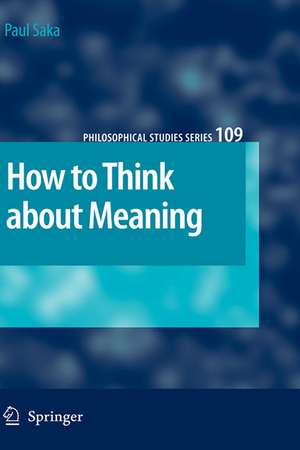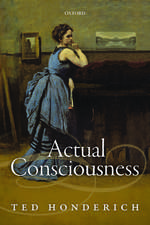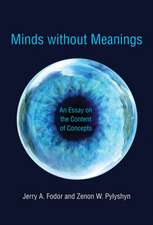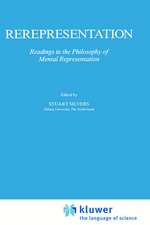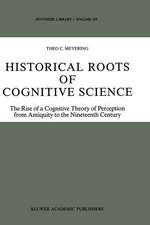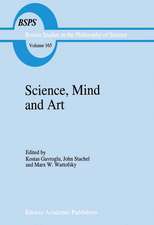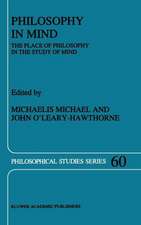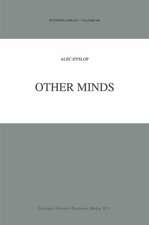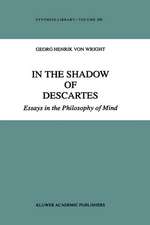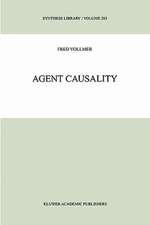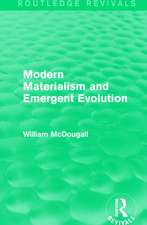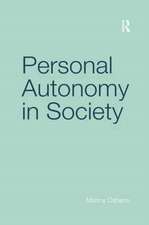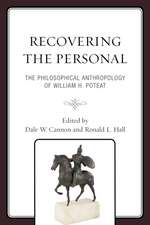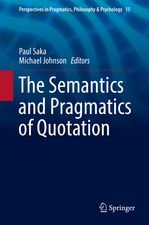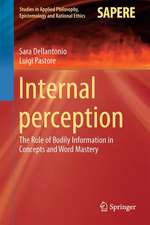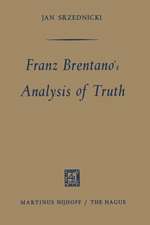How to Think about Meaning: Philosophical Studies Series, cartea 109
Autor Paul Sakaen Limba Engleză Hardback – 24 mai 2007
How to Think about Meaning develops an even more radical mentalist semantics, which it does by shifting the object of semantic inquiry. Whereas for classical semantics the object of analysis is an abstract sentence or utterance such as “Grass is green”, for attitudinal semantics the object of inquiry is a propositional attitude such as “Speaker so-and-so thinks grass is green”. Explicit relativization to some speaker S allows for semantic theory then to make contact with psychology, sociology, historical linguistics, and other empirical disciplines.
| Toate formatele și edițiile | Preț | Express |
|---|---|---|
| Paperback (1) | 944.67 lei 6-8 săpt. | |
| SPRINGER NETHERLANDS – 22 noi 2010 | 944.67 lei 6-8 săpt. | |
| Hardback (1) | 950.66 lei 6-8 săpt. | |
| SPRINGER NETHERLANDS – 24 mai 2007 | 950.66 lei 6-8 săpt. |
Din seria Philosophical Studies Series
-
 Preț: 407.78 lei
Preț: 407.78 lei - 15%
 Preț: 644.95 lei
Preț: 644.95 lei - 18%
 Preț: 1120.18 lei
Preț: 1120.18 lei - 18%
 Preț: 1005.43 lei
Preț: 1005.43 lei - 15%
 Preț: 640.06 lei
Preț: 640.06 lei -
 Preț: 381.21 lei
Preț: 381.21 lei -
 Preț: 391.61 lei
Preț: 391.61 lei - 15%
 Preț: 640.88 lei
Preț: 640.88 lei - 15%
 Preț: 639.25 lei
Preț: 639.25 lei - 18%
 Preț: 1221.51 lei
Preț: 1221.51 lei - 18%
 Preț: 947.18 lei
Preț: 947.18 lei - 18%
 Preț: 955.56 lei
Preț: 955.56 lei - 18%
 Preț: 950.96 lei
Preț: 950.96 lei - 15%
 Preț: 645.47 lei
Preț: 645.47 lei - 15%
 Preț: 635.79 lei
Preț: 635.79 lei - 15%
 Preț: 644.82 lei
Preț: 644.82 lei -
 Preț: 386.00 lei
Preț: 386.00 lei - 15%
 Preț: 644.82 lei
Preț: 644.82 lei - 15%
 Preț: 642.18 lei
Preț: 642.18 lei - 15%
 Preț: 643.48 lei
Preț: 643.48 lei - 18%
 Preț: 944.99 lei
Preț: 944.99 lei - 15%
 Preț: 638.76 lei
Preț: 638.76 lei - 20%
 Preț: 553.25 lei
Preț: 553.25 lei - 20%
 Preț: 560.31 lei
Preț: 560.31 lei - 18%
 Preț: 951.29 lei
Preț: 951.29 lei - 18%
 Preț: 893.40 lei
Preț: 893.40 lei - 20%
 Preț: 566.76 lei
Preț: 566.76 lei - 18%
 Preț: 951.77 lei
Preț: 951.77 lei
Preț: 950.66 lei
Preț vechi: 1159.34 lei
-18% Nou
Puncte Express: 1426
Preț estimativ în valută:
181.93€ • 197.55$ • 152.82£
181.93€ • 197.55$ • 152.82£
Carte tipărită la comandă
Livrare economică 22 aprilie-06 mai
Preluare comenzi: 021 569.72.76
Specificații
ISBN-13: 9781402058561
ISBN-10: 140205856X
Pagini: 300
Ilustrații: XIII, 285 p.
Dimensiuni: 155 x 235 x 28 mm
Greutate: 0.59 kg
Ediția:2007
Editura: SPRINGER NETHERLANDS
Colecția Springer
Seria Philosophical Studies Series
Locul publicării:Dordrecht, Netherlands
ISBN-10: 140205856X
Pagini: 300
Ilustrații: XIII, 285 p.
Dimensiuni: 155 x 235 x 28 mm
Greutate: 0.59 kg
Ediția:2007
Editura: SPRINGER NETHERLANDS
Colecția Springer
Seria Philosophical Studies Series
Locul publicării:Dordrecht, Netherlands
Public țintă
ResearchCuprins
Theoretical Issues.- The Case of the Missing Truth-Conditions.- Foundations of Attitudinal Semantics.- Objections and Replies.- Case Studies.- Hate Speech.- Ambiguity.- Quotation and Use-Mention.- Liars and Truth-Tellers.
Recenzii
“A remarkable new approach to semantic theory. With a refreshing emphasis on meaning as the expression of attitude, Paul Saka not only strikes a blow against vacuous truth-conditional theories, but demonstrates the power of his cognitive analysis in theory and in a surprising and satisfying selection of important linguistic applications. Technically exact, highly readable, and illustrated with valuable examples from many contexts of language use, here is a book to counterbalance decades of misdirected anti-psychologistic semantic dogma.” Prof. Dale Jacquette, Department of Philosophy, Pennsylvania State University, USA
“How to Think about Meaning provides a novel mentalist approach to linguistic meaning, one that is informed by current research methods in cognitive science and the growing influence of cognitive linguistics. It also draws attention to, and provides an analysis of, important aspects of language (such as connotation) that have been neglected by contemporary philosophers of language. There is really nothing unoriginal about this work.” Prof. Marga Reimer, Department of Philosophy, University of Arizona, USA
Textul de pe ultima copertă
According to the dominant theory of meaning, truth-conditional semantics, to explain the meaning of a statement is to specify the conditions necessary and sufficient for its truth. Classical truth-conditional semantics is coming under increasing attack, however, from contextualists and inferentialists, who agree that meaning is located in the mind.
How to Think about Meaning develops an even more radical mentalist semantics, which it does by shifting the object of semantic inquiry. Whereas for classical semantics the object of analysis is an abstract sentence or utterance such as "Grass is green," for attitudinal semantics the object of inquiry is a propositional attitude such as "Speaker so-and-so thinks grass is green." Explicit relativization to some speaker S allows for semantic theory then to make contact with psychology, sociology, historical linguistics, and other empirical disciplines.
The attitudinal approach is motivated both by theoretical considerations and by its practical success in dealing with recalcitrant phenomena in the theory of meaning. These include: presuppositions as found in hate speech, and more generally the connotative force of evaluative language; the problem of how to represent ambiguity; quotation and the use-mention distinction; and the liar paradox, which appears to contradict truth-based semantics.
"Technically exact, highly readable, and illustrated with valuable examples, ...here is a book to counterbalance decades of misdirected anti-psychologistic semantic dogma." Prof. Dale Jacquette, Pennsylvania State University, U.S.A.
How to Think about Meaning develops an even more radical mentalist semantics, which it does by shifting the object of semantic inquiry. Whereas for classical semantics the object of analysis is an abstract sentence or utterance such as "Grass is green," for attitudinal semantics the object of inquiry is a propositional attitude such as "Speaker so-and-so thinks grass is green." Explicit relativization to some speaker S allows for semantic theory then to make contact with psychology, sociology, historical linguistics, and other empirical disciplines.
The attitudinal approach is motivated both by theoretical considerations and by its practical success in dealing with recalcitrant phenomena in the theory of meaning. These include: presuppositions as found in hate speech, and more generally the connotative force of evaluative language; the problem of how to represent ambiguity; quotation and the use-mention distinction; and the liar paradox, which appears to contradict truth-based semantics.
"Technically exact, highly readable, and illustrated with valuable examples, ...here is a book to counterbalance decades of misdirected anti-psychologistic semantic dogma." Prof. Dale Jacquette, Pennsylvania State University, U.S.A.
Caracteristici
Challenges truth-conditional semantics Develops a cognitivist or mentalist theory of meaning Examines the nature of hate speech Examines the nature of ambiguity Proposes a new solution to the semantic paradoxes
